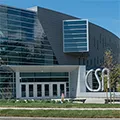
Cleveland Metropolitan School District
Cleveland, OH
Cleveland School of the Arts is a specialty arts school in the Cleveland Metropolitan School District that serves students in grades 8–12.
With their abundant musical, dance, and other talents, students at Cleveland School of the Arts are no strangers to rehearsal and performance. But reading practice and performance also take center stage.
Last year, Cleveland School of the Arts achieved Reading Master School certification. The school has also been recognized as an Ohio School of Promise. And despite a low 19 percent reading score on the Ohio proficiency test before starting Renaissance Accelerated Reader® more than 15 years ago, students doubled that score after just one year with Accelerated Reader and started scoring consistently in the 90s by the third year.
“It’s been a journey, but Accelerated Reader has been the critical piece in our success,” said former Principal Dr. Barbara Walton, who is now retired. “Accelerated Reader not only taught our students how to read and made the difference in our scores, but also engaged parents and brought us together as a faculty. Accelerated Reader has played a huge part in everything we’ve done, and we have a culture of readers to show for it.”
Every sixth- to twelfth-grade student knows there’s no such thing as downtime—that’s more reading time. Reading has become so “cool” that Walton says kids question others who don’t have a book in hand. Parents witness the difference at home. One called to accuse Walton of turning her son into a “reading monster” because suddenly all he wanted to do was read.
“I told her that was a wonderful complaint,” Walton smiled. “It’s such a rewarding experience to watch students who initially struggled with reading go on to graduate with top honors.”
Accelerated Reader was initially implemented at Cleveland School of the Arts to help intermediate students practice state standards at their functional levels—whether second or tenth grade. This approach allowed teachers to address needs of multiple reading levels and still cover necessary standards.
Soon, the program became infused into the entire curriculum for grades six through twelve, whereby every teacher can now be involved with reading and Accelerated Reader. Teachers are asked for topics they will be teaching, and grants help purchase books on those subjects. Students who read and pass the quiz on a social studies-related book, for example, are rewarded in both English and social studies.
Accelerated Reader not only taught our students to read and made the difference in our scores, but also engaged parents and brought us together as a faculty.
Dr. Barbara Walton, Former Principal – Cleveland School for the Arts
Walton said this infusion was a way to further motivate students and give teachers varying levels of materials to support more needs. The school saw a drastic improvement in student behavior-from a daily fight to one or two per year. Accelerated Reader allowed students to work at the appropriate level, replacing feelings of shame with success. Another plus was full faculty buy-in and cohesiveness, which wasn’t always the case.
“We had huge resisters at the onset of Accelerated Reader, and my role was to support the program and say, ‘yes, we’re going to do it,’” Walton said. “For Accelerated Reader to be successful, it must be driven from the top. It’s also critical to empower teachers as leaders and have an Accelerated Reader champion who will troubleshoot, own, and love the program.”
For Walton, that champion was Linda Germo, whose role was to provide a supportive, team approach to using the program. She took teachers through best practices, reading plans, goal-setting, reports, other areas of support, and stayed current on developments. Although it required effort and grants to get to Renaissance® conferences, Germo, Walton, and a team of teachers attended all but one.
“Professional development makes all the difference,” Germo said. “It kept us up to date because Accelerated Reader is constantly evolving based on research, plus it gave us that renewed spark. Ideas we got at those conferences from other educators and the sessions accounted for 90 percent of what we implemented.”
The training helped Germo, in turn, show all teachers how Accelerated Reader could simplify their daily tasks while benefiting students. The key, for both teachers and students, is valuable data.
“Accelerated Reader put a tremendous amount of instant data at our fingertips for any need,” Germo said. “Whether we were trying to determine a need for intervention, group kids for state testing prep, or direct instruction in a certain way, the data allowed us to promptly act on the total history of a student—not just a moment.”
Frequent monitoring of Accelerated Reader data drives instructional decisions and is critical in obtaining grants and keeping parents up-to-date. Parents know to look for weekly TOPS reports. Germo’s go-to resource is the Diagnostic Report, which she ran nightly as the school neared certification for Reading Master School.
“We knew exactly what we had to do to make it, and everyone got into it—it was so exciting!” said Germo, who also retired this summer. “In all my years of teaching, I’ve never worked harder than I did in my 14 years with Accelerated Reader, but I’ve also never gained more satisfaction because of how it grew the kids’ love of reading. For me, test scores were a by-product.”

